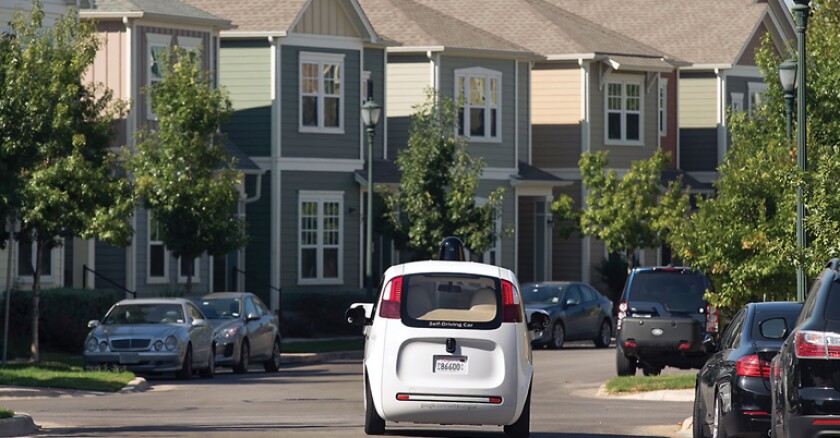But that was before the feds stepped in last week.
In a 114-page guidance, the U.S. Department of Transportation (DOT) made clear that it thought states should take a backseat to the federal government when it comes to the design and manufacture of automated vehicles.
As the feds see it, they're simply continuing to handle things the same way they have for decades: The National Highway Traffic Safety Administration oversees automobiles, while state agencies supervise drivers. Self-driving vehicles, in which the automobile acts as both car and driver, arguably present a gray area. But the federal government said states only regulate “human drivers.”
“As motor vehicle equipment increasingly performs ‘driving’ tasks, DOT’s exercise of its authority and responsibility to regulate the safety of such equipment will increasingly encompass tasks similar to ‘licensing’ of the non-human ‘driver’ (e.g. hardware and software performing part or all of the driving task),” the federal agency wrote.
State officials generally cheered the guidance.
The American Association of Motor Vehicle Administrators, which worked with the DOT in developing the policy, said it “provides a consistent and standardized approach to regulating highly automated vehicles while simultaneously honoring the flexibility and autonomy of each individual state.”
But the new federal guidance could send some states, like California, back to the drawing board.
A spokeswoman said the California Department of Motor Vehicles would take into account the federal document, along with feedback from its public hearings and conversations with manufacturers and software makers, as it decides what changes to make to the draft regulations it issued in December.
The draft rules in California, where 15 companies are currently testing driverless vehicles, “will probably be either substantially reworked or superseded by new legislation,” predicted Bryant Walker Smith, a law and engineering professor from the University of South Carolina who writes about autonomous vehicle regulations at newlypossible.org.
Other states will also likely take a lighter regulatory approach, said Smith. The federal guidance specifically mentions other areas that states may still regulate, including limiting testing in their jurisdictions; requiring human drivers in semi-autonomous cars to be ready to take over in dangerous situations; and continuing to carry out their traditional duties, such as registering and titling vehicles, inspecting cars and trucks for safety reasons, imposing traffic laws and establishing liability laws.
Smith expects industry-friendly states -- such as Florida, Michigan and Texas -- “will largely ignore the more restrictive suggestions in the model policy.” Texas has no law expressly regulating self-driving cars, Florida’s law is already permissive and Michigan lawmakers are currently revisiting their law.
“In fact,” Smith wrote in an email message, “these states may market themselves by actively contrasting their more permissive regimes with this model policy. By and large, developers of these systems don’t want state DMVs promulgating rules more restrictive than what might be achieved through legislation alone (or no legislation whatsoever).”
Kirk Steudle, the director of the Michigan Department of Transportation, encouraged legislators in his state to follow the federal government’s lead.
“The [federal] framework relies on the traditional roles of federal and state governments in regulating autos and operators. We have advocated for that in the current debate and the bills in the [Michigan] House stay true to that principle,” he said.
Developers of autonomous vehicles have said regulations like the proposed California rules were too onerous, and they have tended to reward localities that haven’t interfered with their testing. Pittsburgh, for example, where Uber decided to launch its first driverless vehicles this fall, imposes few restriction on researchers. Officials, in fact, have encouraged companies to develop their autonomous vehicles there.
Underscoring that point, President Obama wrote an op-ed in the Pittsburgh Post-Gazette championing the new federal approach and announcing a White House innovation summit in the city. In the op-ed, Obama stressed the potential safety benefits of self-driving vehicles, along with the need for consistent regulations of those cars and trucks.
“We’re also giving guidance to states on how to wisely regulate these new technologies, so that when a self-driving car crosses from Ohio into Pennsylvania, its passengers can be confident that other vehicles will be just as responsibly deployed and just as safe,” the president wrote.
“Regulation can go too far. Government sometimes gets it wrong when it comes to rapidly changing technologies. That’s why this new policy is flexible and designed to evolve with new advances,” Obama added.
Still, the guidance leaves many questions unanswered.
The framework shows the general approach the federal government plans to use when regulating autonomous vehicles, but it doesn't provide all the details -- and those details matter a great deal to other regulators, manufacturers and advocates.
Linda Bailey, the executive director of the National Association of City Transportation Officials, said the resulting regulations should “be based heavily on urban streets, where people walking, parking, biking and making deliveries create a complex environment for driving.”
The group contends that semi-autonomous vehicles, such as the Tesla Model S that was driving autonomously in a fatal Florida crash in May, should not be allowed in urban environments. The group also urged the DOT to set a speed limit of 25 mph for autonomous vehicles on city streets.









